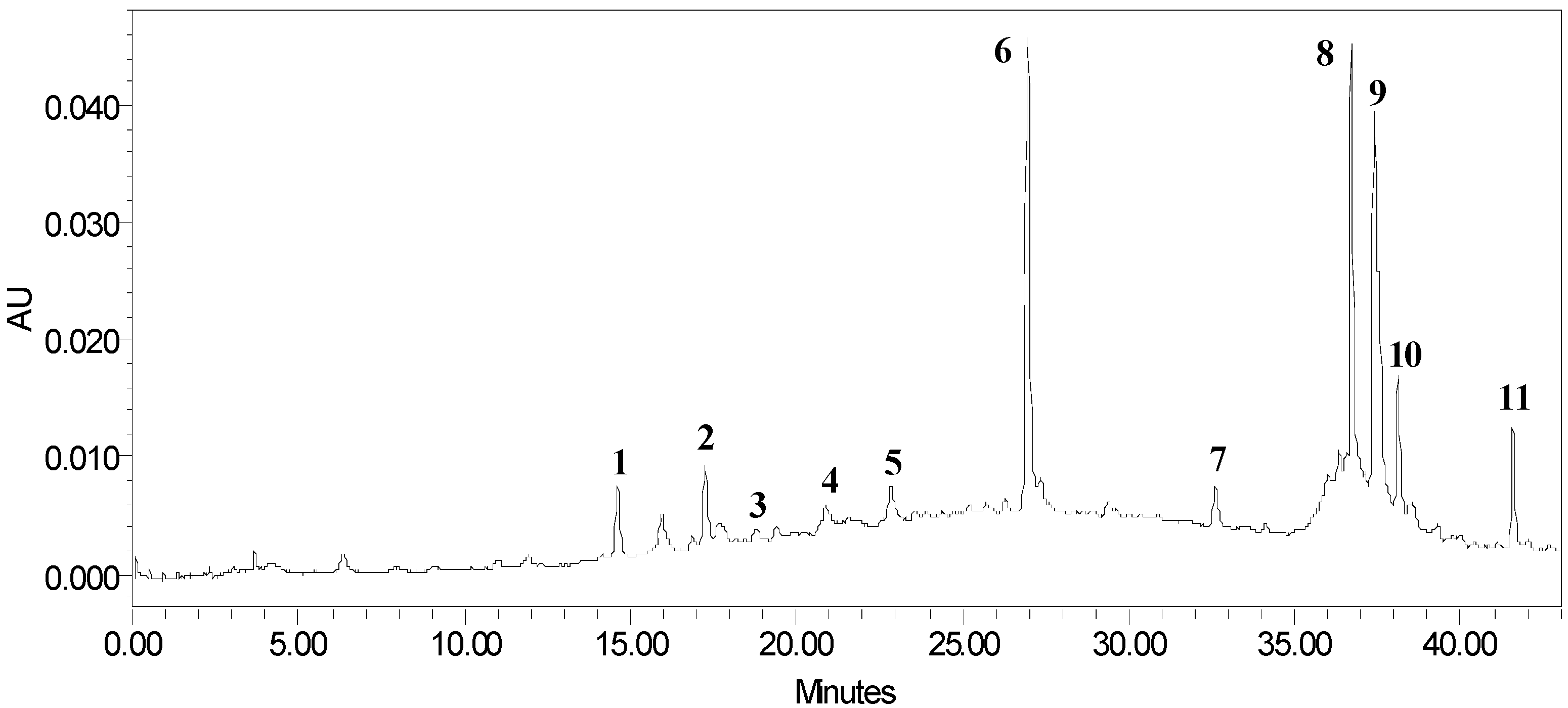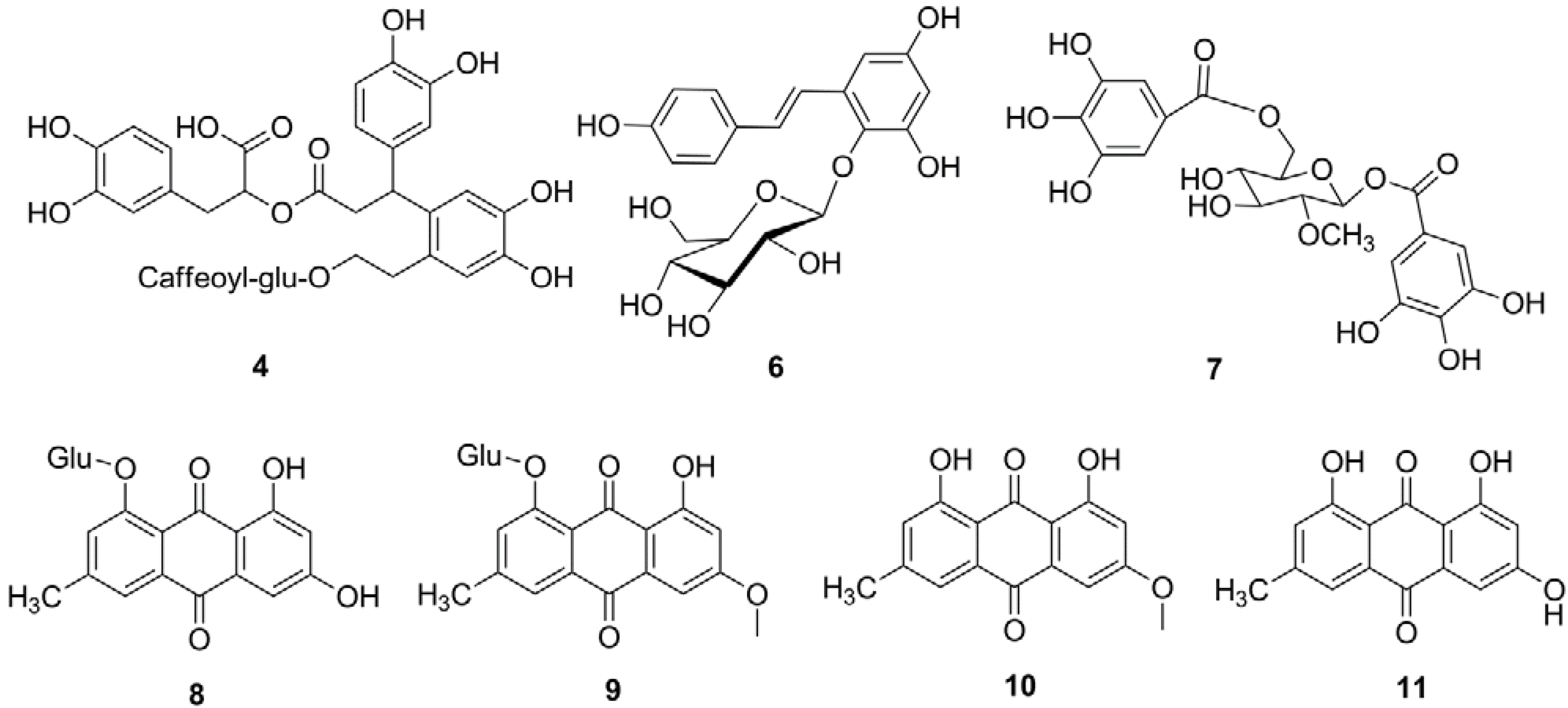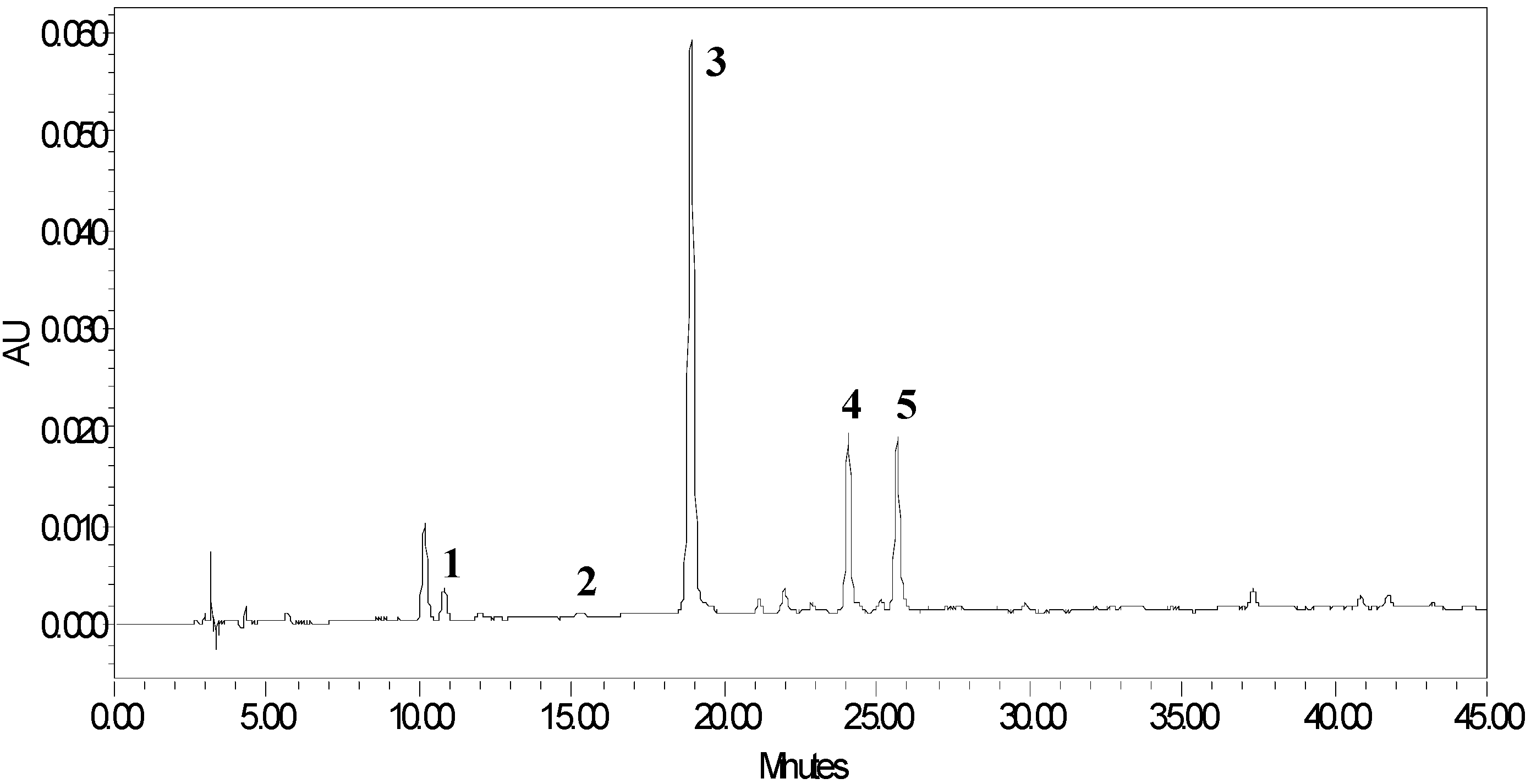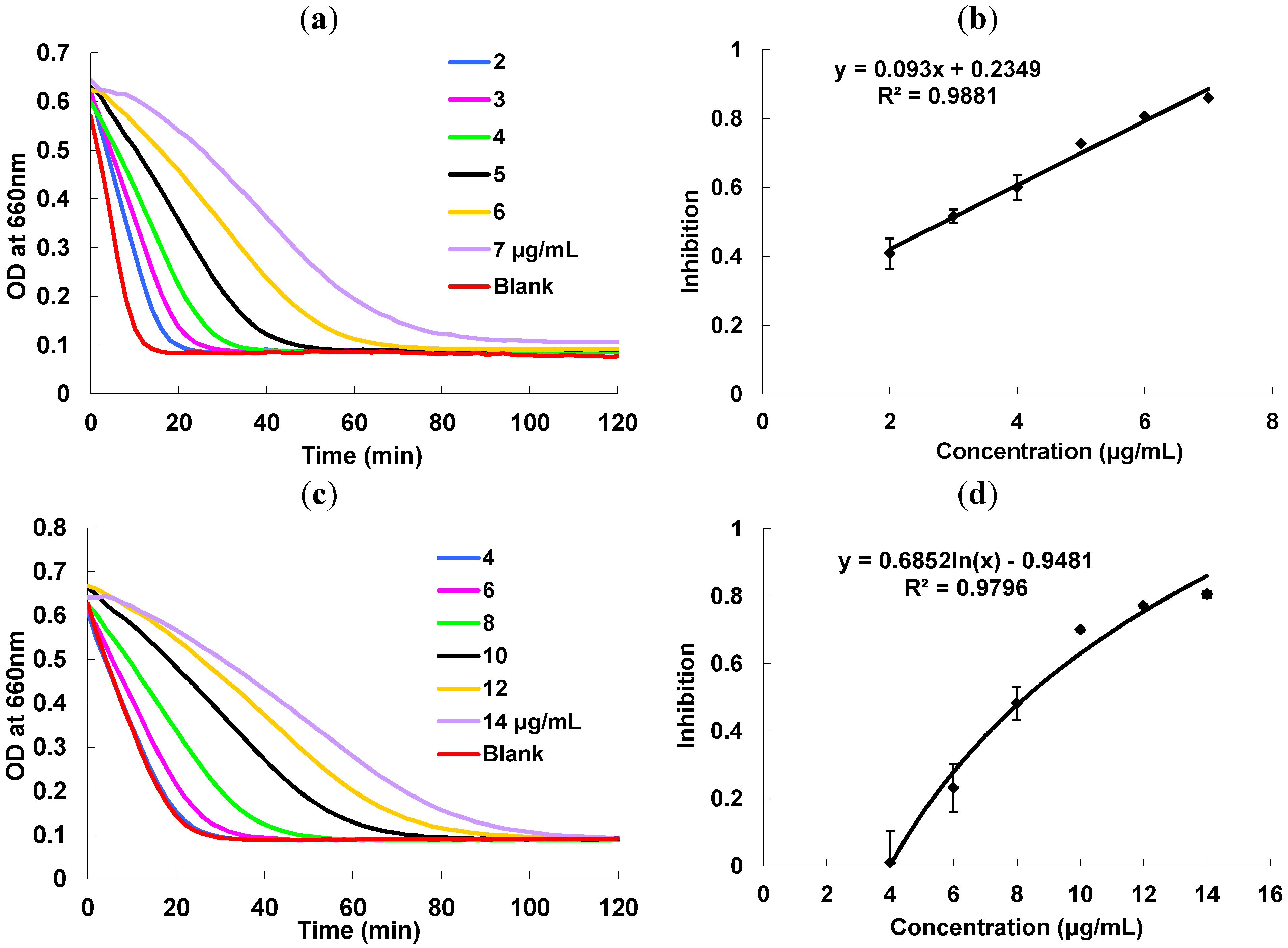Characterization of Proanthocyanidins in Stems of Polygonum multiflorum Thunb as Strong Starch Hydrolase Inhibitors
Abstract
:1. Introduction
2. Results and Discussion
2.1. HPLC and High Resolution Mass Spectra Characterization of Polyphenolic Compounds Extract
2.1.1. Flavan-3-ols

| Peak No. | Compound identity | Measured HRMS m/z [M−H]− | Predicted HRMS m/z [M−H]− | Mass Error (ppm) | MSn fragmentations [M−H]− |
|---|---|---|---|---|---|
| 1 | Dimer, (epi)C2 | 577.1366 | 577.1351 | −2.5 | 451,425,287 |
| Molecular formula | C30H26O12 | ||||
| 2 | Trimer, (epi)C3 | 865.2010 | 865.1985 | −2.8 | 575,407 |
| Molecular formula | C45H38O18 | ||||
| 3 | Trimer, (epi)C2+(epi)CG | 1017.2071 | 1017.2095 | 2.4 | 847,729, 677,577,287 |
| Molecular formula | C52H42O22 | ||||
| 4 | Ester of phenylpropanoid and phenylethanoid glucoside | 839.2396 | 839.2404 | 1.0 | 677,641,515 |
| Molecular formula | C41H43O19 | ||||
| 5 | Tetramer, (epi)C4 | 1153.2572 | 1153.2619 | 4.1 | 863,575,407 |
| Molecular formula | C60H50O24 | ||||
| 6 | Tetrahydroxystilbene glucoside | 405.1190 | 405.1191 | 0.3 | 243,137 |
| Molecular formula | C20H22O9 | ||||
| 7 | Methyl-O-digalloyl-glucoside | 497.0934 | 497.0937 | 0.6 | 345,327 |
| Molecular formula | C21H22O14 | ||||
| 8 | Emodin-O-glucoside | 431.0982 | 431.0984 | 0.3 | 269,241 |
| Molecular formula | C21H20O10 | ||||
| 9 | Physcion-O-glucoside | 445.1149 | 445.1140 | −1.9 | 283,268 |
| Molecular formula | C22H22O10 | ||||
| 10 | Physcion | 283.0599 | 283.0612 | 4.5 | 268,240 |
| Molecular formula | C16H12O5 | ||||
| 11 | Emodin | 269.0445 | 269.0455 | 3.9 | 241,224 |
| Molecular formula | C15H10O5 |
2.1.2. Phenylpropanoids and Stilbenoids

2.1.3. Anthraquinone Derivatives
2.2. HPLC and LC-ESI-MSn Characterization of Proanthocyanidins

| Peak number | Compound identity | m/z [M−H]− | MS2 fragmentation ions |
|---|---|---|---|
| 1 | Dimer, (epi)C2 | 577 | 451,425,287 |
| 2 | Trimer, (epi)C3 | 865 | 575,407 |
| 3 | Trimer, (epi)C2-(epi)CG | 1017 | 847,729,577,287 |
| 4 | Tetramer, (epi)C4 | 1153 | 863,575,407 |
| 5 | Tetramer, (epi)C3-(epi)CG | 1305 | 1179,1017,847,729,577,451 |
| 6 | Pentamer, (epi)C5 | 1441 | 1315,1151,865 |
| 7 | Pentamer, (epi)C4-(epi)CG | 1593 | 1467,1441,1305,1017,727,575,447 |
| 8 | Hexamer, (epi)C6 | 1729 | 1603,1577,1441,1151,1027,863.737,576 |
| 9 | Hexamer, (epi)C5-(epi)CG | 1881 | 1729,1593,1305,1177,1015,865,739 |
2.3. Thiolysis of Proanthocyanidins for HPLC and LC-ESI-MS Analysis

2.4. Starch Hydrolase Inhibition Activity

3. Experimental
3.1. Reagents and Instruments
3.2. Extraction of Polyphenolic Compounds from P. multiflorum Thunb
3.3. Isolation of Proanthocyanidins
3.4. HPLC and Tandem Mass Spectrometry
3.5. Thiolysis of the Proanthocyanidins for HPLC Analysis
3.6. α-Amylase and α-Glucosidase Inhibition Assay
3.7. Statistical Analysis
4. Conclusions
Acknowledgments
References
- China Pharmacopoeia Committee, Pharmacopoeia of the People’s Republic of China; China Chemical Industry Press: Beijing, China, 2004; p. 122.
- Ou, M. Chinese English Dictionary of Traditional Chinese Medicine; The People’s Publishing House: Beijing, China, 1996; p. 509. [Google Scholar]
- Nanaka, G.I.; Miwa, N.; Nishioka, I. Stilbene glycoside gallates and proanthocyanidins from Polygonum multiflorum. Phytochemistry 1982, 21, 429–432. [Google Scholar] [CrossRef]
- Yao, S.; Li, Y.; Kong, L. Preparative isolation and purification of chemical constituents from the root of Polygonum multiflorum by high-speed counter-current chromatography. J. Chromatogr. A 2006, 1115, 64–71. [Google Scholar] [CrossRef]
- Chen, Y.; Wang, M.; Rosen, R.T.; Ho, C.T. 2,2-diphenyl-1-picrylhydrazyl radical-scavenging active components from Polygonum multiflorum Thunb. J. Agric. Food Chem. 1999, 47, 2226–2228. [Google Scholar] [CrossRef]
- Chan, Y.-C.; Wang, M.-F.; Chang, H.-C. Polygonum multiflorum Extracts improve cognitive performance in senescence accelerated mice. Am. J. Chin. Med. 2003, 31, 171–179. [Google Scholar] [CrossRef]
- Chan, E.; Wong, C.Y.-K.; Wan, C.-W.; Kwok, C.-Y.; Wu, J.-H.; Ng, K.-M.; So, C.-H.; Au, A.L.-S.; Poon, C.C.W.; Seto, S.-W.; et al. Evaluation of anti-oxidant capacity of root of Scutellaria baicalensis Georgi, in comparison with roots of Polygonum multiflorum Thunb and Panax ginseng CA Meyer. Am. J. Chin. Med. 2010, 38, 815–827. [Google Scholar] [CrossRef]
- Lv, L.; Shao, X.; Wang, L.; Huang, D.; Ho, C.-T.; Sang, S. tilbene glucoside from Polygonum multiflorum Thunb. A novel natural inhibitor of advanced glycation end product formation by trapping of methylglyoxal. J. Agric. Food Chem. 2010, 58, 2239–2245. [Google Scholar] [CrossRef]
- Ahmed, N.; Thornalley, P.J. Advanced glycation endproducts: What is their relevance to diabetic complications? Diabetes Obes. Metab. 2007, 9, 233–245. [Google Scholar] [CrossRef]
- Wong, C.C.; Li, H.B.; Cheng, K.W.; Chen, F. A systematic survey of antioxidant activity of 30 Chinese medicinal plants using the ferric reducing antioxidant power assay. Food Chem. 2006, 97, 705–711. [Google Scholar] [CrossRef]
- Wang, H.Y.; Liu, T.T.; Song, L.X.; Huang, D.J. Profiles and alpha-amylase inhibition activity of proanthocyanidins in unripe Manilkara zapota (Chiku). J. Agric. Food Chem. 2012, 60, 3098–3104. [Google Scholar] [CrossRef]
- Murata, T.; Miyase, T.; Yoshizaki, F. Hyaluronidase inhibitory rosmarinic acid derivatives from Meehania urticifolia. Chem. Pharm. Bull. 2011, 59, 88–95. [Google Scholar] [CrossRef]
- Ye, M.; Han, J.; Chen, H.; Zheng, J.; Guo, D. Analysis of Phenolic compounds in rhubarbs using liquid chromatography coupled with electrospray ionization mass spectrometry. J. Am. Soc. Mass Spectrom. 2007, 18, 82–91. [Google Scholar]
- Chen, W.; Fu, C.; Qin, Y.; Huang, D. One-pot depolymerizative extraction of proanthocyanidins from mangosteen pericarps. Food Chem. 2009, 114, 874–880. [Google Scholar] [CrossRef]
- Liu, T.; Song, L.; Wang, H.; Huang, D. A high-throughput assay for quantification of starch hydrolase inhibition based on turbidity measurement. J. Agric. Food Chem. 2011, 59, 9756–9762. [Google Scholar] [CrossRef]
- Fu, C.; Loo, A.E.K.; Chia, F.P.P.; Huang, D. Oligomeric proanthocyanidins from mangosteen pericarps. J. Agric. Food Chem. 2007, 55, 7689–7694. [Google Scholar] [CrossRef]
- Fu, C.L.; Chen, W.; Quek, Y.L.; Ni, R.Y.; Ghani, A.B.A.; Leong, W.W.Y.; Zeng, H.Q.; Huang, D.J. Sustainability from agricultural waste: Chiral ligands from oligomeric proanthocyanidins via acid-mediated depolymerization. Tetrahedron Lett. 2010, 51, 6322–6324. [Google Scholar]
- Sample Availability: Not available.
© 2013 by the authors; licensee MDPI, Basel, Switzerland. This article is an open access article distributed under the terms and conditions of the Creative Commons Attribution license (http://creativecommons.org/licenses/by/3.0/).
Share and Cite
Wang, H.; Song, L.; Feng, S.; Liu, Y.; Zuo, G.; Lai, F.; He, G.; Chen, M.; Huang, D. Characterization of Proanthocyanidins in Stems of Polygonum multiflorum Thunb as Strong Starch Hydrolase Inhibitors. Molecules 2013, 18, 2255-2265. https://doi.org/10.3390/molecules18022255
Wang H, Song L, Feng S, Liu Y, Zuo G, Lai F, He G, Chen M, Huang D. Characterization of Proanthocyanidins in Stems of Polygonum multiflorum Thunb as Strong Starch Hydrolase Inhibitors. Molecules. 2013; 18(2):2255-2265. https://doi.org/10.3390/molecules18022255
Chicago/Turabian StyleWang, Hongyu, Lixia Song, Shengbao Feng, Yuancai Liu, Gang Zuo, Fuli Lai, Guangyuan He, Mingjie Chen, and Dejian Huang. 2013. "Characterization of Proanthocyanidins in Stems of Polygonum multiflorum Thunb as Strong Starch Hydrolase Inhibitors" Molecules 18, no. 2: 2255-2265. https://doi.org/10.3390/molecules18022255




